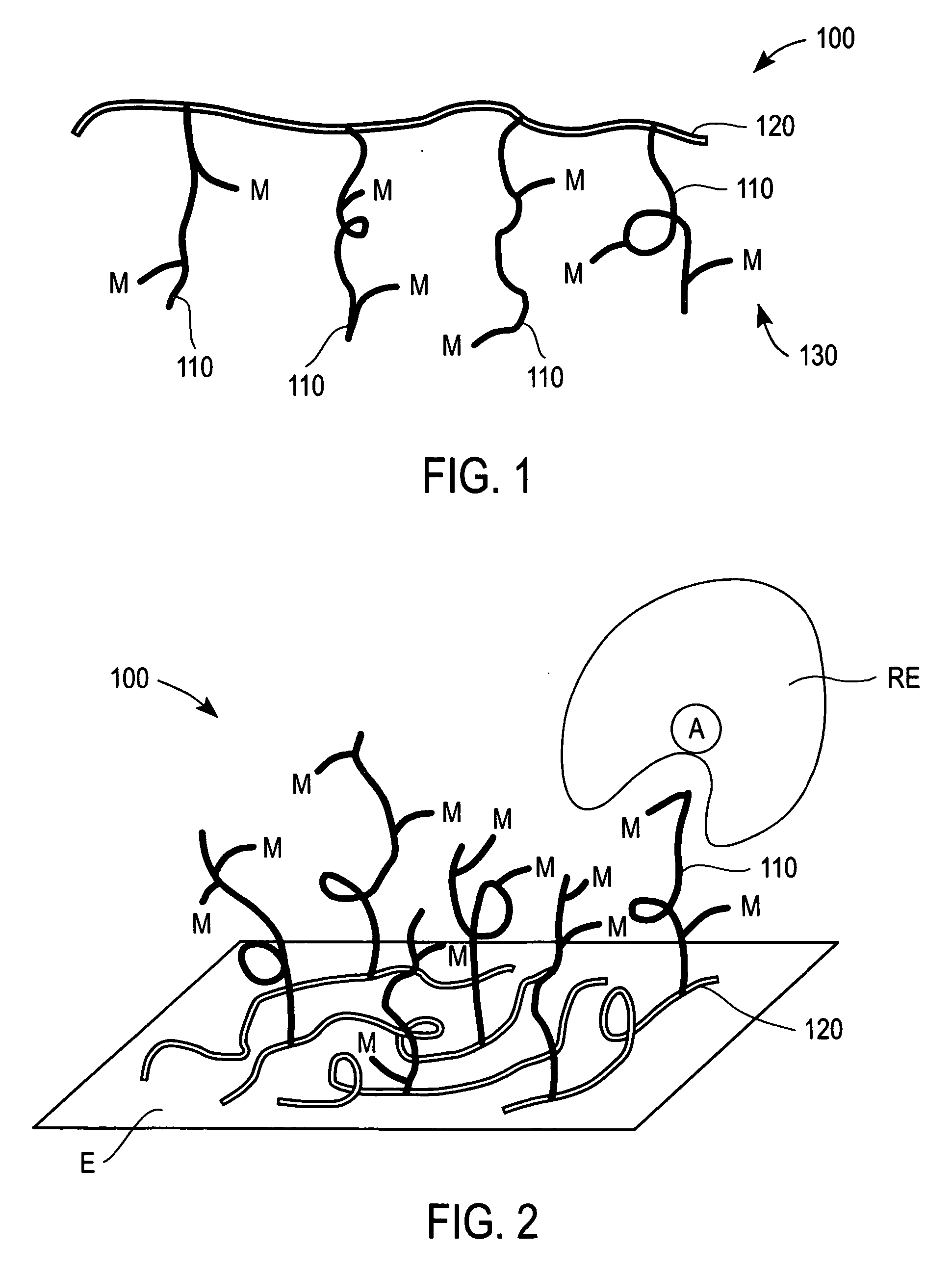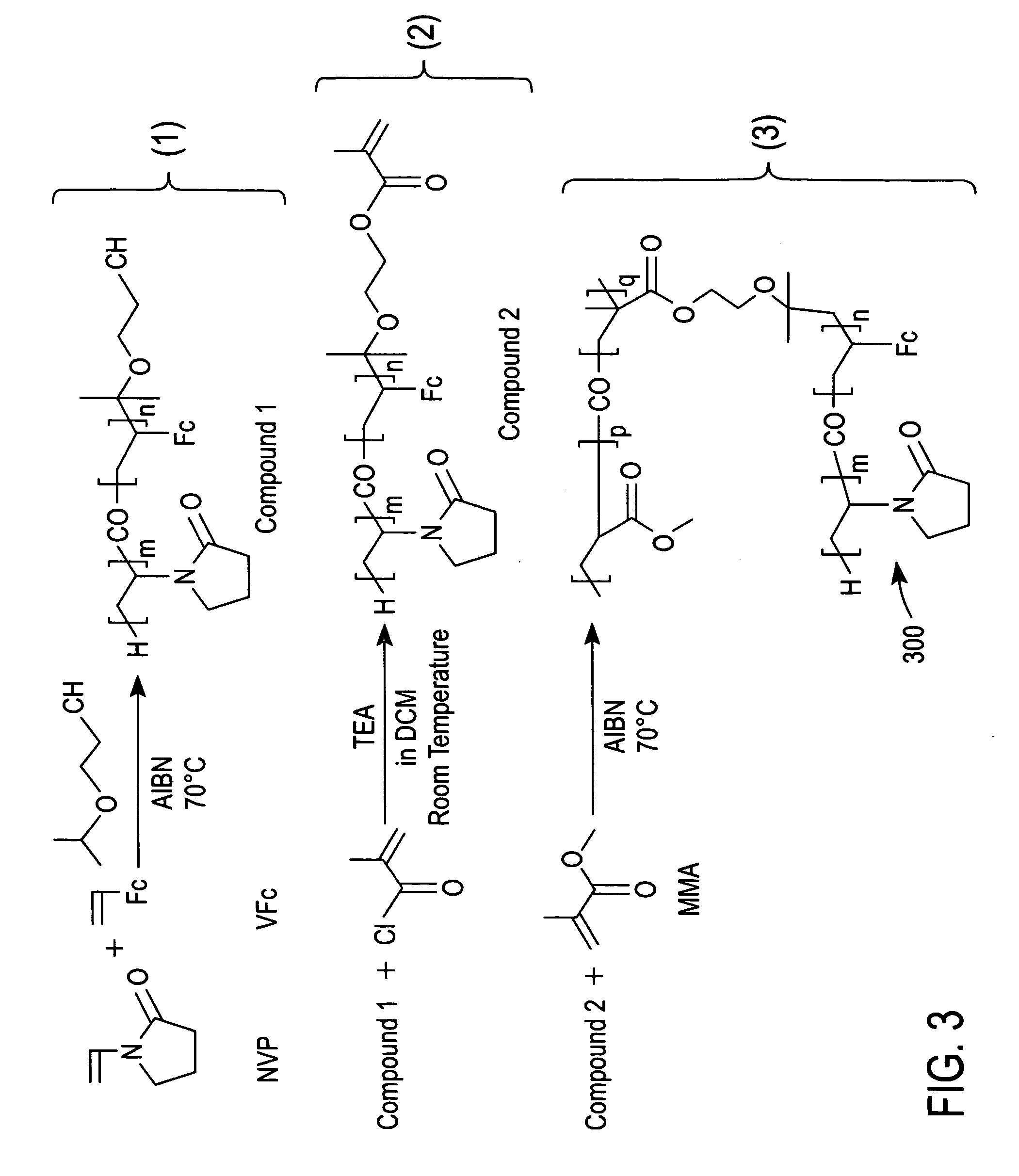Redox polymers for use in electrochemical-based sensors
a technology of electrochemical and polymer, applied in the field of polymers, can solve the problems of reducing the activity of redox enzymes of such chemical compositions, unable to readily leachable redox mediators, and low flexibility, and achieve the effect of adequate redox mediator activity
- Summary
- Abstract
- Description
- Claims
- Application Information
AI Technical Summary
Benefits of technology
Problems solved by technology
Method used
Image
Examples
example 1
Synthesis of Compound 1 of FIG. 3
[0046] Compound 1 of FIG. 3 was synthesized via free radical co-polymerization using a reaction solution of 10.2 g of NVP, 0.88 g of VFc and 0.05 g of 2.2′-azobisisobutyronitrile (AIBN) in 15 ml of IPEtOH. The synthesis was performed in a round bottom flask.
[0047] Before initiating the synthesis, the reaction solution was deoxygenated by bubbling nitrogen therethrough for one hour. The reaction flask was then heated to 70° C. in an oil bath for 24 hours with continuous magnetic agitation under a nitrogen atmosphere. Compound 1 in the reaction solution was dissolved in dichloromethane and precipitated from the reaction solution with diethyl ether. Next, the precipitated Compound 1 was filtrated off and dried in an oven at 50° C.
example 2
Synthesis of Compound 2 of FIG. 3
[0048] Compound 2 was synthesized by reacting 2.0 g of Compound 1 (prepared as described in Example 1 above) with 0.8 g of methacryloylchloride in the presence of 1.2 g of dry triethylamine in 20 mL of dry dichloromethane. The reaction was performed overnight in a round bottom flask at room temperature with continuous magnetic agitation under a nitrogen atmosphere.
[0049] The reaction solution was subsequently washed with a solution containing 0.1 N HCl, 0.5 N potassium carbonate and distilled water. The organic phase of the resulting solution was then collected and concentrated by using a rotary evaporator at room temperature under reduced pressure, thereby producing a purified sample of Compound 2. The purified sample of Compound 2 was subsequently dried in an oven at 50° C.
example 3
Synthesis of a Redox Polymer According to an Embodiment of the Present Invention (i.e., Redox Polymer 300 of FIG. 3)
[0050] Redox polymer 300 (an ampiphilic polymer) was synthesized by free radical co-polymerization using 1.0 g of Compound 2, 6.2 g of MMA, and 0.06 g of AIBN in 60 mL of 1-pentanol. The reaction was performed in a round bottom flask.
[0051] Before initiating the reaction, the 1-pentanol solvent was deoxygenated by bubbling nitrogen therethrough for one hour. The reaction solution was then heated to 70° C. in an oil bath for 24 hours with continuous magnetic agitation under a nitrogen atmosphere. Redox polymer 300 was precipitated out of the reaction solution with diethyl ether and then dried in an oven at 50° C.
PUM
| Property | Measurement | Unit |
|---|---|---|
| Molecular weight | aaaaa | aaaaa |
| Molar ratio | aaaaa | aaaaa |
| Hydrophilicity | aaaaa | aaaaa |
Abstract
Description
Claims
Application Information
 Login to View More
Login to View More - R&D
- Intellectual Property
- Life Sciences
- Materials
- Tech Scout
- Unparalleled Data Quality
- Higher Quality Content
- 60% Fewer Hallucinations
Browse by: Latest US Patents, China's latest patents, Technical Efficacy Thesaurus, Application Domain, Technology Topic, Popular Technical Reports.
© 2025 PatSnap. All rights reserved.Legal|Privacy policy|Modern Slavery Act Transparency Statement|Sitemap|About US| Contact US: help@patsnap.com



